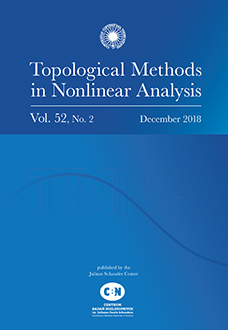Abstract
The following $T^2$-equivariant problem of periodic type is considered: $$ \begin{cases} u\in C^2({\mathbb R}^2,{\mathbb R}),\\ -\varepsilon\Delta u(x,y)+F'(u(x,y))=0 & \text{in ${\mathbb R}^{2}$,}\\ u(x,y)=u(x+T,y)=u(x,y+S) &\text{for all $(x,y)\in {\mathbb R}^2$,}\\ \nabla u(x,y)=\nabla u(x+T,y)=\nabla u(x,y+S) &\text{for all $(x,y)\in {\mathbb R}^{2}$.} \end{cases}\tag{\text{P}} $$ Using a suitable version of Morse theory for equivariant problems, it is proved that an arbitrarily great number of orbits of solutions to (P) is founded, choosing $\varepsilon> 0$ suitably small. Each orbit is homeomorphic to $S^1$ or to $T^2$.
Citation
Giuseppina Vannella. "Morse theory applied to a $T^{2}$-equivariant problem." Topol. Methods Nonlinear Anal. 17 (1) 41 - 53, 2001.
Information





